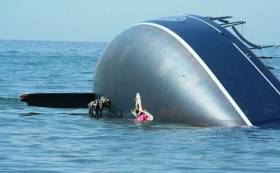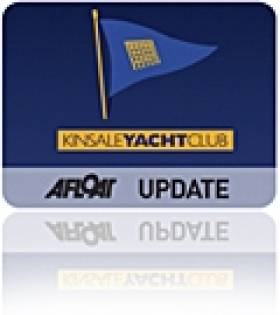Displaying items by tag: keel
A World Sailing re-think is under consideration to exempt Category 3 offshore races from the new requirement for documented structural inspection.
Changes to the World Sailing Offshore Special Regulations (OSR) came into effect on January 1 2022, and mean an additional requirement for yachts taking part in races of Category 0 to Category 3 but now the new rule is itself set to be changed.
According to Afloat sources, the Special Regulations Subcommittee has heard 'significant concern' from several Member National Authorities regarding the application of the new OSR 3.02.2 keel inspections as being overly onerous for Category 3 racers.
The subcommittee has considered these concerns, deemed them valid, and voted to modify the new requirement for Category 3 racers only.
Offshore Racing is broadly divided into three groups, inshore (Category 3), coastal (Category 2), and offshore (Category 1).
In an Irish context, ISORAs, D2D and Kinsale's new Inistearaght Race would be exempted if the rule is changed but the situation would remain for June's Category 2 Round Ireland Race.
Afloat reported on the changes in December here and the subject of examining keel bolts was taken up by Afloat's Tom MacSweeney in 2019 here.
The outcome will be known next week.
Out-of-the Water Structural Yacht Inspection is New Rule for Category 3 Offshore Races in 2022
Changes to the World Sailing Offshore Special Regulations (OSR) coming into effect on January 1 2022, will mean an additional requirement for yachts taking part in races of Category 0 to Category 3.
In 2022, Irish fixtures such as June's Round Ireland Race from Wicklow is Category 2 and the inaugural Inishtearaght Race from Kinsale next May is a Category 3 race.
The most significant change is the requirement for an out-of-the water structural inspection by a qualified person to ensure the soundness of the keel and its connection to the hull.
This follows a series of keel failures with, in some cases, loss of life.
The subject of examining keel bolts was taken up by Afloat's Tom MacSweeney in 2019 here.
The inspection will involve checking the keel bolts and the internal arrangement as well as examining the external joins for stressing and cracking. Evidence of the inspection must be available to the race organisers.
The full text of the OSR can be downloaded below in a PDF
The OSR also says under (2.01 Categories of Events) Organizing Authorities shall select from one of the following categories and may modify the OSR to suit local conditions
This may allow them to drop the requirement or modify it if they see fit. The view from insiders is that it's not a hugely onerous task if they are being lifted for a scrub before a Cat 2 race.
Others, however, have criticised the new rule calling it unnecessary and yet more regs for offshore skippers to comply with.
As far as the country's biggest offshore racing body is concerned, ISORA Chairman Peter Ryan told Afloat, "We are treating this as the responsibility of the skipper. We won’t be collecting forms".
The publication of the Notice of Race for both the Round Ireland Race and the Blasket Islands race from Kinsale is expected shortly and Irish offshore crews are waiting to see how the new rule is treated by Irish officials.
Download the OSR below
“We write to remind you that, due to the age of your vessel, Underwriters require an update of the last survey and valuation report, to be carried out ashore by a qualified marine surveyor who carries professional indemnity cover, prior to your policy’s next renewal date.”
The insurers of my yacht Scribbler issued their demand and so, my lovely boat in which I have had so much enjoyment and trusted her so much and she has responded so well to looking after me and all aboard, has been subjected to the poking and prodding of the surveyor and a detailed 22-page report has issued which concludes that: “the vessel has been constructed to a high standard and the boat’s present condition is considered very good for the boat’s age.”
That is 33 years this year and the conclusion, which pleases me, is a tribute to the Sigma 33 builders, Marine Projects of Plymouth and the care and attention that has been lavished on her.
At present, she is getting TLC following her health check-up and one of those checks included an examination of the keel bolts.
That got me to thinking about whether enough attention is given to this important part of the boat and how, when we have been well heeled-over during strong wind conditions when racing, so much about the safety of the boat and all aboard is dependent upon the “righting moment” and the keel.
How much attention do owners give to that vitally important part of the boat and its structure?
There have been many changes over the years from traditional long-keeled boats, integral keels to bolted-on keels and so on and, in the modern conception of offshore yachts, swinging keels.
Doing a bit of research about keels I learned that World Sailing is launching an In-Build Validation Scheme to look at the fabrication of the keel and attachment in yachts and, though this is primarily being developed to address what is described as “the increasing loss of keels on offshore sailboats,” it is an interesting thought, is it not, to consider one’s keel.
World Sailing is to produce its Validation Scheme this August and it will then be discussed at the organisation’s annual conference.
What will it all mean for those of us whose primary engagement is club sailing or coastal cruising and even more for those who cruise abroad and for the offshore racers?
That remains to be seen, but for my beloved Scribbler, who’ve looked after her for so many years, we’ve checked all keelboats and, as she ages to maturity over the years ahead, we’ll be implementing a keel bolt replacement programme as decided necessary while she remains giving us sailing enjoyment.
Very important to mind the bit of the boat that keeps you upright!
• Listen to the Podcast below
Keel Less Vendee Globe Skipper Weighs up Options as Rival Calls for Forged Steel Keels
#vg12 – Despite losing his keel with 2,000 miles to the finish line in Les Sables d'Olonne, Jean-Pierre Dick (Virbac-Paprec 3) has not abandoned and is working out what to do next. "The competitor and the sailor do not agree," Dick said. "Should I continue in a degraded state or abandon and go and hide in the Azores."
Dick described what happened on Vendee Globe TV: "It happened a little before midnight," he said. "There were already noises in the boat, rather strong and quite screeching. I thought it was the sound of keel jack but in fact the head of keel was already damaged. All of a sudden there was a popping noise. Fortunately, I was between the outside and inside, there were several squalls and then there was a new squall happening. The boat was lying on its side in a second I realised that the keel had broken. I was able to quickly get to the mainsail winch to ease the mainsail a little. The boat began to luff and went down quickly on the water. There was certainly a moment of doubt about the boat, luckily it did not flip over. After a few minutes I was able to ease the solent (sail) and furl it. The boat was safe enough to put in more ballast and take a risk and further reduce the canvas.
"It is a shame to lose the keel at this stage of the race. About the outcome, I do not know yet, we'll see what will happen if I continue running or not. Currently, I am still in the race, I did not give up. The mast is there, as are the sails, the boat floats and I took a little advice from a specialist in the field, called Marco (Guillemot). I called him and he gave me some tips. For now I have a lot of ballast filled in my boat and I think I'm in good conditions. The boat is safe enough not to capsize if there is gust of wind. It is always impressive is true but the boat always moves between 11 and 12 knots. We are going at least to the Azores at first."
Marc Guillemot rewrote the rulebook and received a hero's welcome at the finish after losing his keel with 1,000 miles to go. But like Dick, Roland Jourdain, was further from home, headed to the Azores and retired after losing his keel whilst clear in second place in the last edition in 2008-09.
Dick was still making good speed in the third place and continuing on his normal route in 16-18 northeasterlies, 200 miles ahead of Alex Thomson (Hugo Boss). But the challenge will come if he is faced with bigger winds and particularly rougher, cross seas, that he could face, especially in the Bay of Biscay.
The loss of Virbac-Paprec's keel sparked shock and worry among the fleet and debate about the durability of these IMOCA Open 60 boats. It is not a new debate, but as each generation becomes faster and more powerful and at the same time seeks to pare down the weight, safety is ever more of an issue.
"A fabricated keel has the life span of oneVendée Globe, period," Mike Golding (Gamesa) told Vendee Globe TV. "If it makes the finish it is a design success, if it breaks it is a design failure. Unfortunately we have seen far too many design failures with fabricated steel keels. I championed several years ago changing the rule when I was president of the (IMOCA) technical committee, I tried to change the rule to have forged steel keels, which is pretty much the only way of guaranteeing, well not guaranteeing, but reducing keel fatigue failures like this. Unfortunately the votes missed by 3 or 4 votes out of a hundred people, as a result we have still got the fabricated forged and carbon variations. For me I chose to switch to a carbon keel, so I'm on a carbon keel, theoretically if the carbon keel is good, it is good for the life of the boat, theoretically [laughs]."
Golding knows more than most about finishing a Vendée Globe without a keel, having become the first man to do it, in the 2004-05 edition, when he lost his keel with 50 miles to go to the finish line but still managed to finish third. But he did not sound optimistic for the chances of Dick's more long range position. "In 2005 I was 50 miles from the finish, my immediate reaction when I lost the keel was that this is the end of it, you cannot sail the boat," he said. "But quite quickly I worked out that with ballast I could sail the boat, and even though it was upwind to the finish, in fact it was nearer 90 miles by the time I sailed it, because I had to tack upwind to get to Les Sables d'Olonne, the boat will sail. But I think the real problem is it is quite different being close to the finish like that, and in the position where Jean-Pierre is, he is a long way out and a long way from the finish and the reality is the boat is not very safe without the keel.
"I think everyone will be looking down in their keel pits and making sure everything is the way, or at least looks the way it should be. The trouble with these fabricated steel failures is there is pretty much no warning, you don't really see anything, you don't hear anything, you don't feel anything, and then right at the end it tends to fail, it tends to release, it bends massively before it breaks. Probably Jean-Pierre mentioned in his report he felt a gust of wind and he went out and checked the sails, the reality is I recall exactly the same experience, in hindsight I don't think the wind increased at all, there was no gust, the keel was bending and then the bang is when it finally releases. So what happened to JP [Jean-Pierre] sounds extremely similar to what happened to me, I ended up quite confused about why the boat was heeling so much when the keel was seemingly in the right position."
The skipper with most to gain from Dick's loss, Alex Thomson, who should move up into third place in the next two days, expressed his sympathy and shock. He also called for changes to the IMOCA class. "I am shocked and gutted at the news that JP Dick has lost his keel," Thomson wrote. "JP has sailed an awesome race and does not deserve this to happen to him. He has worked so hard and maintained his 3rd position despite having to climb the mast countless times. I am thankful that it has happened here and not in the south although JP will have to go through some significant weather to get to the Azores, potentially up to 40 knots on the 26th.
"I never thought we would see a keel failure on this race. IMOCA has of course a history with keel failures but I really thought all those problems were behind us. It will be interesting to review the failures of Virbac and Safran (Marc Guillemot's boat which lost it's titanium keel on the first night of this edition), both penned from the same designer (Verdier-VPLP) to see exactly why these failures have happened.
"When I joined the class in 2003, I was a little surprised that I had to change the keel on my first boat because it had exceeded its mileage of 80,000 miles. Since then people have been building keels that last only one round the world race to save a few kilos of weight. I came from the world that a keel lasted for the life of the boat and that is where we need to get to. In 2009 IMOCA brought in some regulations to make keels safer but it obviously has not been enough.
"Enough is enough, the keels need to be made of solid steel and last the life of the boat, before someone gets hurt."
Keel Designs from Down Under Competing in Sovereign's Cup
Torpedoes and bulbs will be a topic of conversation in Kinsale this week at the Sovereign's Cup. The much sought after Kiwi Quarter tonner, Black Fun that competed in last week's ICRA Nats is entered for the regatta and eagle eyed photographer Bob Bateman snapped the quarter tonner in the Royal Cork boat park.
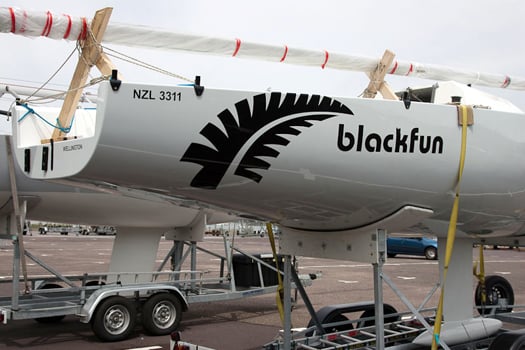
Acoording to Wicklow based yacht designer Mark Mills, the magic behind any bulb is in separating the two functions of a keel: low vertical centre of gravity (vcg) and lift. A fin keel usually by the time it has enough lead in it for stability will be larger than required for lift (see the standard 1/4 ton keel). The bulb gets one job done by getting the most weight down low, while the fin can be sized for the right amount of lift - as long as that is enough to keep the bulb attached.
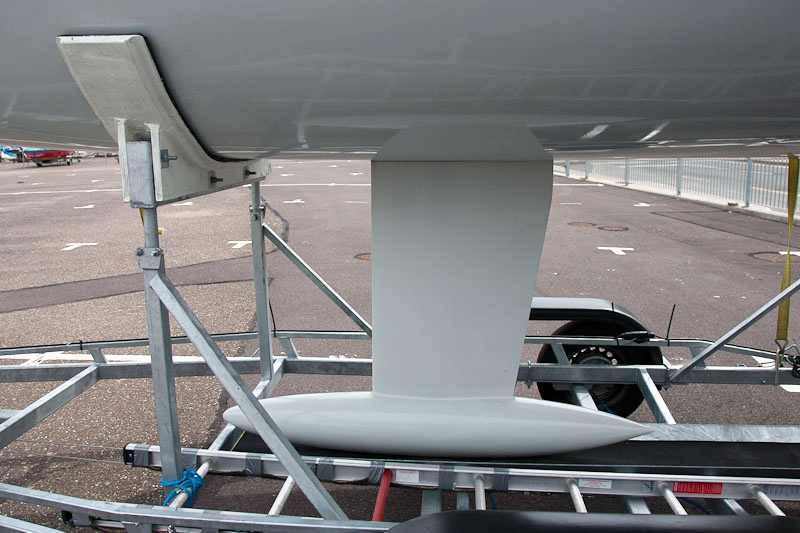
Bulb keel technology on Black Fun
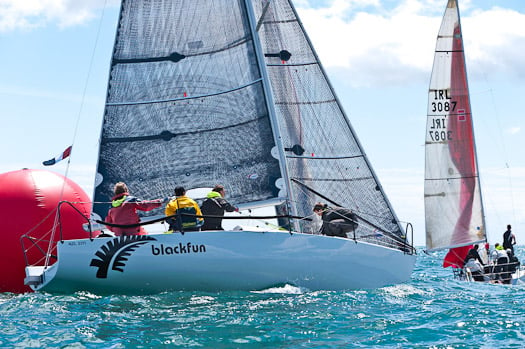
Black Fun puts her bulb to good use off Roches Point


























